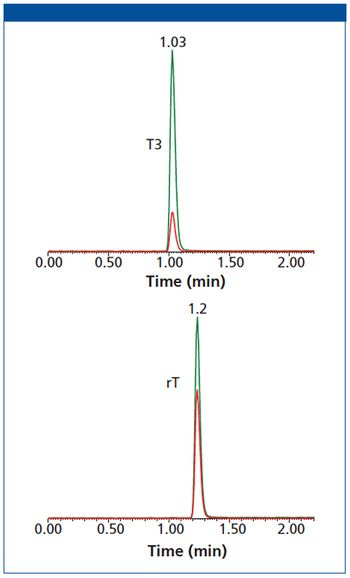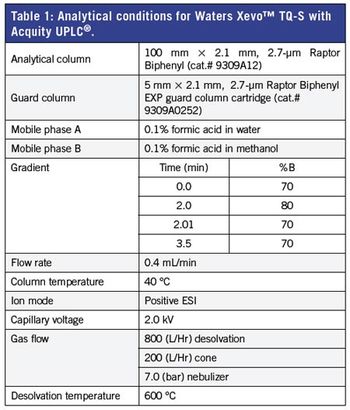
Liquid chromatography (LC) is proving to be a valuable complementary technique to gas chromatography (GC) in cannabis testing for the analysis of cannabinoids, mycotoxins, and pesticides.

Liquid chromatography (LC) is proving to be a valuable complementary technique to gas chromatography (GC) in cannabis testing for the analysis of cannabinoids, mycotoxins, and pesticides.

A model set of analytes and selected applications are used to demonstrate the effects that buffers can have on the selectivity of a separation and the sensitivity of a reversed-phase analysis when using MS detection.

Buffers are commonly used in reversed-phase liquid chromatography (LC) to control the ionization state of analytes. However, the addition of buffers is much more complex than simple pH control. Complex equilibria exist between these mobile-phase additives, the analytes, the silica surface, and even the stationary phase in certain circumstances. The addition of mass spectrometry (MS) as a primary detection technique makes decisions about mobile-phase additives even more crucial. In this column instalment, we use a model set of analytes and selected applications to demonstrate the effects that buffers can have not only on the selectivity of a separation, but also on the sensitivity of a reversed-phase analysis when using MS detection.

In recent years industry has been moving to columns with smaller and smaller inner diameters - moving from 4.6 mm and 3.0 mm i.d. columns to 2.1 mm, 1.0 mm, and even smaller. While small inner diameter columns have some clear advantages, they also bring challenges. Reduction of extracolumn volumes must be given greater consideration by both customers and manufacturers. This article focuses on the sources of band broadening within high performance liquid chromatography (HPLC) columns with an emphasis on eddy dispersion. The physical mechanisms of dispersion are discussed and a review of the current literature as it pertains to small inner diameter columns is presented.


In recent years industry has been moving to columns with smaller and smaller inner diameters-moving from 4.6 and 3.0 mm i.d. columns to 2.1 mm, 1.0 mm, and even smaller. While small inner diameter columns have some clear advantages, they also bring challenges. Reduction of extracolumn volumes must be given greater consideration by both customers and manufacturers. Additionally, experimental evidence suggests that the very narrow confinement of chromatographic particles can result in packed bed structures that promote increased dispersion and reduced efficiency. This article focuses on the sources of band broadening within high performance liquid chromatography (HPLC) columns with particular emphasis on eddy dispersion. The physical mechanisms of dispersion are discussed and a review of the current literature as it pertains to small inner diameter columns is presented.



The global demand for fish as a natural source of fresh animal protein, essential fats, minerals, and vitamins continues to rise with the human population.

Pain management LC analyses can be difficult to optimize due to the limited selectivity of C18 and phenyl-hexyl phases.

Pain management LC analyses can be difficult to optimize because of the limited selectivity of C18 and phenyl-hexyl phases.



Published: October 2nd 2014 | Updated:

Published: December 1st 2014 | Updated:

Published: March 1st 2015 | Updated:

Published: June 1st 2015 | Updated:

Published: June 1st 2015 | Updated:

Published: June 30th 2015 | Updated: